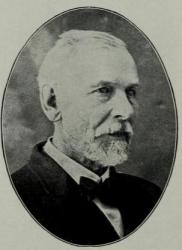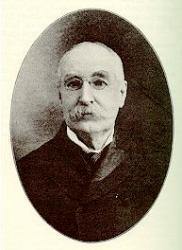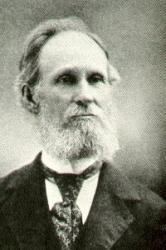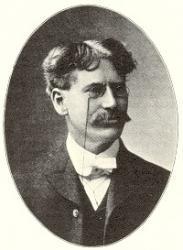Planning worship?
Check out our sister site, ZeteoSearch.org,
for 20+ additional resources related to your search.
- |
User Links
Person Results
‹ Return to hymnal








Export as CSV
E. R. Latta

1839 - 1915 Hymnal Number: 156 Author of "No More Good-Byes" in Grateful Praise Rv Eden Reeder Latta USA 1839-1915. Born at Haw Patch, IN, the son of a Methodist minister, (also a boyhood friend of hymn writer Willam A Ogden) he became a school teacher. During the American Civil War he preached for the Manchester Methodist Church and other congregations (possibly as a circuit rider filling empty pulpits). In 1863 he married Mary Elizabeth Wright, and they had five children: Arthur, Robert, Jennie, two others. He taught for the public schools of Manchester, and later Colesburg, IA. He moved to Guttenberg, IA, in the 1890s, and continued writing song lyrics for several major gospel composers, including William Ogden, James McGranahan, James Fillmore, and Edmund Lorenz. He wrote 1600+ songs and hymns, many being widely popular in his day. His older brother, William, composed hymn tunes. He died at Guttenbert, IA.
John Perry
E. R. Latta
William G. Tomer
1833 - 1896 Person Name: W. G. Tomer Hymnal Number: 155 Composer of "[God be with you till we meet again]" in Grateful Praise Born: October 5, 1833, New Jersey.
Died: September 26, 1896, New Jersey.
Buried: Union Cemetery, Finesville, New Jersey.
Tomer studied singing and sang in the choir in Finesville, New Jersey, and began teaching school at age 17. He served in the Union army during the American civil war, then worked as a clerk in Washington, DC, served as music director for Grace Methodist Episcopal Church, and taught school in New Carpentersville and Greenwich, New Jersey. He was living in Greenwich as of 1880.
--www.cyberhymnal.org/
William G. Tomer
Edmund S. Lorenz

1854 - 1942 Person Name: E. S. Lorenz Hymnal Number: 20 Composer of "[Across life's rugged mountains]" in Grateful Praise Pseudonymns: John D. Cresswell, L. S. Edwards, E. D. Mund,
====================
Lorenz, Edmund Simon. (North Lawrence, Stark County, Ohio, July 13, 1854--July 10, 1942, Dayton, Ohio). Son of Edward Lorenz, a German-born shoemaker who turned preacher, served German immigrants in northwestern Ohio, and was editor of the church paper, Froehliche Botschafter, 1894-1900.
Edmund graduated from Toledo High School in 1870, taught German, and was made a school principal at a salary of $20 per week. At age 19, he moved to Dayton to become the music editor for the United Brethren Publishing House. He graduated from Otterbein College (B.A.) in 1880, studied at Union Biblical Seminary, 1878-1881, then went to Yale Divinity School where he graduated (B.D.) in 1883. He then spent a year studying theology in Leipzig, Germany.
He was ordained by the Miami [Ohio] Conference of the United Brethren in Christ in 1877. The following year, he married Florence Kumler, with whom he had five children. Upon his return to the United States, he served as pastor of the High Street United Brethren Church in Dayton, 1884-1886, and then as president of Lebanon Valley College, 1887-1889.
Ill health led him to resign his presidency. In 1890 he founded the Lorenz Publishing Company of Dayton, to which he devoted the remainder of his life. For their catalog, he wrote hymns, and composed many gospel songs, anthems, and cantatas, occasionally using pseudonyms such as E.D. Mund, Anna Chichester, and G.M. Dodge. He edited three of the Lorenz choir magazines, The Choir Leader, The Choir Herald, and Kirchenchor. Prominent among the many song-books and hymnals which he compiled and edited were those for his church: Hymns for the Sanctuary and Social Worship (1874), Pilgerlieder (1878), Songs of Grace (1879), The Otterbein Hymnal (1890), and The Church Hymnal (1934).
For pastors and church musicians, he wrote several books stressing hymnody: Practical Church Music (1909), Church Music (1923), Music in Work and Worship (1925), and The Singing Church (1938). In 1936, Otterbein College awarded him the honorary D.Mus. degree and Lebanon Valley College the honorary LL.D. degree.
--Information from granddaughter Ellen Jane Lorenz Porter, DNAH Archives
Edmund S. Lorenz
William Boyce

1711 - 1779 Hymnal Number: 144a Composer of "[O come, let us sing unto the Lord: Let us heartily rejoice in the strength of our salvation]" in Grateful Praise William Boyce (baptised 1711 – d. 7 February 1779) was an English composer and organist.
See also in:
Wikipedia
William Boyce
Palmer Hartsough

1844 - 1932 Hymnal Number: 13 Composer of "[I will call upon God; and the Lord shall save me]" in Grateful Praise Rv Palmer Hartsough USA 1844-1932. Born in Redford, MI, he attended Kalamazoo College and Michigan State Normal school (later MSU). He became an author, editor, lyricist, and librettist. After working as a traveling singing teacher in MI, IL, IA, OH, KY and TN, he opened a music studio in Rock Island, IL, around 1877, also directing music at a Baptist church there. In 1893, due to his poetic abilities, he moved to Cincinnati, OH, and joined the Fillmore Music Company, providing texts (over 1000) for their music. He also served as music director at the Bethel Mission and the 9th Street Baptist Church. He became a traveling song evangelist in 1903, and was ordained a Baptist minister in 1906, serving in Ontario, Canada, and MI from 1914 to 1927. He then returned to Plymouth, MI, where he lived the rest of his life. He never married, but was close to his two sisters, and wrote them a weekly letter for many years. With Fillmore Company he helped publish 20 songbooks. He died in Plymouth, MI.
John Perry
Palmer Hartsough
Eben E. Rexford

1848 - 1916 Person Name: E. E. Rexford Hymnal Number: 24 Author of "We are Soldiers" in Grateful Praise Rexford, Eben Eugene.M (Johnsburg, New York, July 16, 1848--October 16, 1916, Shiocton, Wisconsin). Horticulturalist and editor of a Wisconsin farm journal. Many of his verses were used to fill empty corners of the journal. He also wrote many books on gardening. Lawrence University (Appleton, Wisc.), Litt.D. Twenty-five years, organist at First Congregational Church, Shiocton.
See: Smith, Mary L.P. (1930). Eben E. Rexford; a biographical sketch. Menasha, Wis., George Banta Pub. Co.
--Leonard Ellinwood, DNAH Archives and Gabriel, Charles H. (1916). Singers and Their Songs. Chicago: The Rodeheaver Company.
===============
Rexford, Eben Eugene , an American writer, born July 16, 1848, is the author of Nos. 199, 246, 263, 353, in I. D. Sankey's Sacred Songs and Solos), 1878, No. 5, and 456 in the Methodist Sunday School Hymnbook, 1879.
--John Julian, Dictionary of Hymnology, Appendix, Part II (1907)
================
Rexford, E. E. , p. 1587, ii. Additional hymns by this author in common use include:—
1. He saw the wheat fields waiting. Harvest of the World.
2. O where are the reapers. Missions.
3. Rouse up to work that waits for us. Duty.
4. We are sailing o'er an ocean. Life's Vicissitudes.
--John Julian, Dictionary of Hymnology, New Supplement (1907)
================
Eben E. Rexford
J. H. Tenney

1840 - 1918 Hymnal Number: 49 Composer of "[Closer to thee, my Father, draw me]" in Grateful Praise John Harrison Tenney, 1840-1918
Born: November 22, 1840, Rowley, Massachusetts.
Born just after the presidential campaign of "Tippecanoe and Tyler, too," Tenney was named after American president William Henry Harrison. A deacon in the Congregational Church in Linebrook, Massachusetts, he edited or was associate editor of over 30 books, and contributed to hundreds more. His works include:
American Male Choir
Temperance Jewels, with Elisha Hoffman (Boston, Massachusetts: Oliver Ditson & Company, 1879)
Bells of Victory, with Elisha Hoffman (Boston, Massachusetts: Oliver Ditson & Company, 1888)
Gems of Gospel Song
Golden Sunbeams
Sharon’s Dewy Rose
Songs of Faith
Shining Light
Songs of Joy
Sparkling and Bright
Spiritual Songs, Nos. 1 and 2
Sweet Fields of Eden
The Beacon Light
The Singing School Banner
The Anthem Offering
The American Anthem Book
The Crown of Praise
Sources--
Hall, pp. 219-22
Music--
Asilomar
Bogotá
Beyond the Swelling Flood
Cancún
Come to Jesus
Ever Will I Pray
Hallowed Hour of Prayer
Jesus Is Passing This Way
Jubilate!
My Anchor Is Holding
Nothing Between
Onward Christian Soldiers
Sabbath Bell
San Francisco
We’ll Never Say Goodbye
Where Will You Spend Eternity?
--www.hymntime.com/tch
J. H. Tenney
J. B. Herbert

1852 - 1927 Person Name: Dr. J. B. Herbert Hymnal Number: 88 Composer of "[Hark! the throng of angel voices]" in Grateful Praise
J. B. Herbert
Fred A. Fillmore

1856 - 1925 Hymnal Number: 41 Composer of "[Humble praises, holy Jesus]" in Grateful Praise Born: May 15, 1856, Paris, Illinois.
Died: November 15, 1925, Terrace Park, Ohio.
Buried: Milford, Ohio.
Frederick Augustus Fillmore, who was born on May 15, 1856, in Paris, IL, one of seven children, five sons and two daughters, born to Augustus Damon and Hannah Lockwood Fillmore. His father was a preacher in the Christian Church, as well as a composer,
songbook compiler, and hymn publisher who developed his own system of musical notation using numbers on the staff in place of note heads. Augustus eventually settled in Cincinnati, OH, and established a music publishing business there. Until 1906, there was no official distinction between "Christian Churches" and "Churches of Christ." The names were used pretty much interchangeably, and many older churches of Christ which are faithful today were once known as "Christian Churches."
Fred and his older brother James took over their father's publishing business following the death of Augustus in 1870 and established the Fillmore Brothers Music House. This became a successful Cincinnati music form, publishing church hymnals and later band and orchestral music. For many years the firm issued a monthly periodical, The Music Messenger. The brothers edited many hymnbooks and produced many songs which became popular. Beginning with the songbook Songs of Glory in 1874, there appeared many Fillmore publications which became widely used through churches, especially in the midwest. For these collections, Fred provided a great deal of hymn tunes.
--launch.groups.yahoo.com/group/hymnoftheday
Fred A. Fillmore
Richard Farrant
1525 - 1580 Hymnal Number: 144b Composer of "[I was glad when they said unto me, Let us go into the house of the Lord]" in Grateful Praise Like many composers of his day, the early years of Richard Farrant’s (c.1525- November 30, 1580) life are not well documented. The first acknowledgment of him is in a list of the Gentleman of the Chapel Royal in 1552. It is assumed from that list that his birth was around 1525. Although, that cannot be accurately determined. During his life he was able to establish himself as a successful composer, develop the English drama considerably, founded the first Blackfriar Theatre, and be the first to write verse-anthems. He married Anne Bower, daughter of Richard Bower who was Master of the Chapel Royal choristers at the time. With Anne he conceived ten children, one of whom was also named, Richard.
As a member of the Gentleman of the Chapel Royal, Farrant was active in ceremonies surrounding the royal family. He began his work with the Chapel Royal around 1550 under the reign of Edward VI. Fortunately, for Farrant, this is a time that saw huge developments in Latin Church Music. Composers like William Byrd and Christopher Tye were busy expanding and elaborating on the Church Music of the day. In Farrant's twelve years with the Chapel Royal, he was able to participate in funerals for Edward VI and Mary I, and coronations for Mary I and Elizabeth I. After his work there, he took up a post as organist at St. George’s Chapel at Windsor.
For Farrant, the post at at Windsor became a permanent one that he retained for the rest of his life. Along with this, he also acquired the position of Master of the Chapel Royal choristers in November of 1569. Having the choirs of both of these institutions at his disposal gave him an outlet to showcase all of his compositions and plays. In fact, every winter he was able to produce a play for the Queen herself. These positions also allowed him to move back to London in 1576 and begin a public theater of sorts where he rehearsed some of his choir music openly. It was soon after, in 1580, that he passed away, having left his house to his wife.
Unlike many composers of his day that stuck to only music composition, Farrant also wrote many plays. One of his most important contributions to drama in England is of course the creation of the first Blackfriars Theatre. This eventually became one of the most important places in London for drama to develop during the Renaissance. Farrant is also one of the earliest and most well known composers that began to mix the two mediums of music and drama. It was this uncommon mixture that allowed him to begin to develop the composition style of 'verse.' This becomes prominent in a lot of his pieces including the anthems "When as we sat in Babylon" and "Call to remembrance" and "Hide not thou thy face."
--en.wikipedia.org/wiki/
Richard Farrant


 My Starred Hymns
My Starred Hymns


